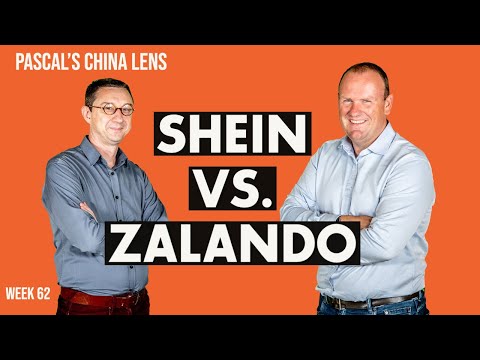Should Zalando be worried by SHEIN in Europe? Can SHEIN business model prevail in the West?

Pascal, in Europe, the largest fashion retailer is Zalando; they own three percent of the entire European fashion market, but their ambition is to grow to 10%, and the strategy behind that is becoming a fashion platform will that be enough to keep SHEIN from winning the European market? I doubt it, because everything's changed today. It's all about Tik Tok and SHEIN is called the Tik Tok of e-commerce; and so this is all about real-time fashion. So, people on Tik Tok, on Instagram, they see these things on SHEIN; they go and buy, it but then this data goes directly to the factory, so the factories can produce it instantly and that's a disruption of a business model that I think will go global; but SHEIN is one of the first ones to do that and they're disrupting this whole model and market. So, let's go and look into all these facts about SHEIN and Zalando. SHEIN is a company that you might not have heard of before. But if you got kids or you're young yourself, generation z, then you probably bought some products from SHEIN, specifically on Tik Tok or Instagram. I mean kids are really crazy about buying all this fashion from this company that nobody ever heard about before. But then suddenly, the world woke up when they saw that
this was the most downloaded app in fashion of any app in the world and most importantly the number of active users, daily, monthly, I mean it was just way more than Zara, than H&M, and many like Uniqlo, all these brands that everybody knows now SHEIN was beating them hands down. So, what is this company so special and why are they achieving this attention from these Tik Tok users? Now, one of the things to think about SHEIN is to look at how the traditional model works of fashion typically it's designers from fashion brands that are designing products, they're designing clothes and then they get sourced usually from China or from Asia. They put them in the stores and consumers just buy them. That's the normal model that we all know, and we all go shop for products in these stores. But that changed a little bit with Zara and and other companies that understood that the customer has to be centric; and the customer has to be central, meaning that we have to not just create trends or design trends for the customer but look what the customer wants as new trends So, a lot of designs that customers wanted these were the trends that the designers were looking for and so, it turned it around a little bit, but the rest of the model was the same and then you have what we call direct to consumer D2C. And that's all about exactly the same as what ZARA does for example. But you replace the shops, the stores, with the internet
and this is where Zalando is. And they're really doing an excellent job at that. And this is all about customer centricity and it's all about understanding what the new trends are, and offering a very good service and loyalty to these customers. But now this model is getting disrupted by what we call the C2M model. From M2C manufacturing to consumer, it's now going to from consumer to manufacturing. And so all these four items are becoming one. It means that
everything starts to get interconnected. How does this work? Well, if you think about SHEIN, what you see in their system, is that they've managed to connect the products, the app stores that they have on SHEIN that is usually through Tik Tok or Instagram. They know how to find these these products, and then they get to SHEIN apps, this data goes directly into the back end system of SHEIN in their ERP system, the enterprise resource planning system, but that also goes then directly into the system of the factory even into the workshops, or the workflow of the garments producers, the manufacturers. And so, that's the real secret it's going all the way from the user, the data, directly to the factory, to the people producing the clothes. What that means is that suddenly when people want more, or like a certain trend is more trendy, or a certain design is more in favor, and people are buying more of one certain product, or one t-shirt or whatever, it is then suddenly these factories can adapt in real-time; and that's why we call that real time fashion, but it's also called the Tik Tok of e-commerce; because it's all to do with attention and so the reason that SHEIN is so good at it is because they combined four things: they combined the experiences that people have, think about Tik Tok, and just wanting to be part of it; and fashion is ideal for that you constantly want new new shoes, or new clothes, and specifically kids, they want to show off with that. And then combine that and integrate that with the AI and the
Big Data, that these platforms have platforms like from Alibaba's Tmall, or jd.com, competitor of Alibaba, or SHEIN, or in china you have Pinduoduo; and so these are platforms that are combining all that data and then sending that to the factory. And because the factory is now smart, they actually know how to produce, what to produce, when to produce, and that makes it so efficient. And the creators don't always have to be designers anymore. The whole world can create, specifically in fashion now.
And so, combining all that through data makes it extremely smart, and that's why I think China and specifically SHEIN as a company in China has an advantage because what they do is they create what I call the new factory and this is about combining the attention factory the addiction factory which is all about Tik Tok; they want to show off; but they also are getting addicted to buying those new clothes, and getting changed constantly of taste and and designs, because they can do it ; and then the brands that used to be the big brands are now getting competition from the factories that feel if we have all that data we know what to produce we might as well become a brand ourself; and that's the brand factory, that is being created. And ultimately, because of this connection through 5G, IoT, AI, big data all coming together these factories are becoming extremely smart. Now, SHEIN has some real challenges one of them is quality; because if the turnaround is so fast and people constantly are changing the designs and and it's not by seasons anymore this is by minutes now, you always have production that isn't right. And then there's a lot of copycats as well
in design so they have to real problems to tackle there. And for a company like SHEIN that is not that old they still need to get their act together; and for them it's really hard to figure out how to keep up with the speed of real-time fashion. Culturally and geopolitically they're having challenges because if people are designing from everywhere in the world then they might design things that works for one culture but is offensive in another culture; and there could be some problems there. So, they're facing a lot of problems from the outside that they didn't know existed very often. It is because they don't have control over these designs anymore And then of course the environment if you ship so many products, you ship so many packages, it's a huge issue. Now, talking about the offer you can't refuse, I think there's a number of things that SHEIN is really doing great: Cheaper products. I mean everybody wants cheaper products
specifically in fashion. If the quality is good then why pay more money. Having fast fashion, you want constantly change and and be with the trends that are today, and trends is not about a season it's really about the trend today and tomorrow. And then also the engagement. I mean users have a kind of feeling that they belong to this change, and these trends that are happening on a daily basis and the trends is really what it's all about. So, I think SHEIN is for the users generation
they're very much definitely an advantage and a convenience that many of them are so addicted to that they wouldn't want to do without SHEIN anymore. But they're also a partner in life because it's about personalisation. And when you think about fashion this is about your identity and so people really want to have a company like SHEIN that offers them the products, the goods the shoes, the clothes, the skirts, everything that fits them their own personal identity And these creators they now have the opportunity to be part of these new trends and don't have to wait for the designers of the brands anymore, You can do it yourself. And so, this is all
becoming a lifestyle platform and so this is what is interesting which SHEIN, and SHEIN is not just about providing cheaper products. This is about identity, it's about lifestyle and so if you can satisfy the needs of the lifestyle of young people, I mean that's a good position to be in. And that creates communities exactly what is needed in fashion. Finally I do believe saving the world and saving the planet is critical and so there are real problems with all this environment and all this packaging but on the other hand, having a better prediction on the demand is a great advantage, because you know how much to produce you don't have so much waste that you do. Because you know exactly the amount that needs to be produced. You can upscale, downscale invest or not invest there's a lot of control on the supply chain through the whole systems which means that you can also help these factories to optimise for the environment; and you don't have any inventory so in all i think there's a lot of challenges. But I also believe maybe it's an opportunity and a way to help also save the planet and SHEIN could contribute there too Let's talk about ZALANDO. And first of all there's something unique about ZALANDO in this
whole video series that we're making. This is the only European company that is actually on the list. ZALANDO is based in in Berlin, They got their headquarters there, and they're serving the european market and they basically started off as a platform that is selling fashion like a traditional store would do, but then online. The future of ZALANDO is becoming a platform where they will facilitate to other fashion brands and retailers to sell online in with the same quality standards as ZALANDO has. And they're working on that; they're working
on different partnerships to make sure that by doing so that they extend their footprint in Europe. So, today for instance they have about three percent of the total fashion market of every fashion item that is being sold in Europe. They have three percent of that market but their ambition is to get to 10% and they will do that not just by leveraging their own platform but by leveraging all other fashion brands and helping them to go online in a qualitative way. So, this is their ambition. But there are a number of challenges on on their way and and one of them is definitely linked to their service they have: a high quality service which means that you can send all the goods back you know how that works; but 50% of every item that is leaving the ZALANDO warehouse also gets back to them. So, that amount is huge and i remember that I went to Zalando a couple of years ago in Berlin. And that just at that time there was like this case study of this
Belgian journalist that checked out how far you can go with that service and they this journalist basically ordered a bunch of clothes and then destroyed them, put paint on it, and used scissors and rubbed toothpaste on it. So, destroyed it and then she sent it back to see what Zalanda would do. And that journalist just got her money back. No questions asked. And for many people that was like the final evidence that Zalando would never make money, because they're too naive in this. And I was at the Zalando headquarters, and I talked about this with them and I said: guys, how do you deal with this? And i still remember the answer that they gave me. They asked the question back and they said: Steven, if you are a customer of a company would you like to have a relationship built on trust or build on control? And obviously I'm like, it has to be relationship based on trust. And the truth is the majority of the organisations tries to control the customer relationship versus Zalando, they really have this mindset that they want to create trust.
So, this is how it goes. This journalist now that ruined everything is now flagged in the system and if she would do that again, she would get two flags. I mean you can make a mistake you, can even do a second mistake. That happens in the best families. But if she would do that three times in a row then, it's game over; and she will never ever buy something on zalando again. So, they
take that into account but their philosophy is we're not gonna change the basic fundamental rule just because there is a handful of people that takes advantage of our system. In the meantime of course they dive into their data and they try to understand what they can do to make sure that they lower the amount of abuse without lowering the service at the same time. So, they added these tags now to clothes that, you know, if you buy something expensive then the risk is there that you would wear it to go to a party and then send it back. They have this huge tag that they
integrate in it, so that you would like an idiot if you would wear it. And that you only send it back if it's really something that isn't suited for you or or if you don't like it after all. So, they're working on different strategies to reduce that amount of returns but at the heart of their business they want to keep that trustworthy relationship that's one of the challenges and that's how they deal with it. The second one of course is competition
this video is about Zalando versus SHEIN. SHEIN is one of those examples of a new company that most of us didn't know about in the last until two years ago or maybe until a few months ago; but they are growing in market share so rapidly that it becomes a threat and the question is has zalando invested enough in customer loyalty in the past couple of years while they had the chance to do that. They have Zalando plus which is like amazon prime, but then for them it makes sure that you have a faster delivery of goods, that you have more information, and so on and so on. But if i can
be critical critical about this I have the feeling that this isn't going far enough; this isn't creating a lock-in. So, when new competitors come, the question is will the relationship that zalando has with its customers be strong enough to survive? And now we have the offer you can't refuse model a bottom layer of product price and service. a minimum demand, digital convenience more and more at minimum demand becoming partner in life, broadening your services and understanding what people want and adding value to society. And if you bring those four together in one experience for
customers then you have an offer you can't refuse. Now, how is Zalando performing on these? Of course if you look to digital convenience this isn't pure e-commerce player they basically invented convenience. So, the the ultimate convenience being commodity is something that they can deal with. They know that we live in a world of zero tolerance for digital inconvenience but they're trying to build new features, they're working with visual search, so if you see someone a friend or someone in a restaurant.,or in a bar, and you like their shoes, you can just use yours Zalando
search take a picture of it, scan it, and then they will give you the same product or similar products so you see that they're going beyond to just click to order and that they're trying to figure out ways to make it as easy as possible for you to find the kind of fashion that you would like Then, if we talk about partner in life? There are two sides to this. The first one is partner in fashion their goal is to make sure that they help you to find products that fit in your personal branding that fit in your fashion style. So, they're working on artificial intelligence and machine learning on that; and they have this algorithmic fashion companion and this is basically a tool that tells you: okay, you bought this t-shirt, you bought these jeans, these shoes and these are items that fit with it; so they try to automatically get you a full outfit. I think this is a first step if you compare that for instance with a site or a platform like stitch fix These guys go a lot further in this. when you go to stitch fix you have to answer this whole set of questions click on images of products that you like and dislike; and based on that information they will provide you with with suggestions. But the cool thing about stitch fix is that they also
add a subscription model to it and you can decide to get new fashion items every week, every month, every quarter. And they will take care of that it's almost like a surprise. It's like serendipity that they create for you. Zalando isn't going that far. So, until now they're focusing on these new technological tools. I think the next step for them is to become a real partner in fashion and making sure that they work with different business models to help customers with that the other side of the story is becoming a partner for brands and this is the heart of their strategy They want to go from three percent market share to 10% market share the way to get there is making sure that they deliver an outstanding service towards all the partners that they make sure that they make the customers of their customers as happy as possible and become a partner in business And then you have the top of the model changing your world. And Zalando is trying to do as much as they can in terms of lowering their own footprint. They're investing a lot in that, but for me the really interesting part is how can they leverage their network. How can they leverage
their customer base to lower the CO2 emissions. Because let's be honest we all know that the fashion industry is one of the big causes of pollution and climate issues in the world. The impact of the global fashion industry is higher than the impact of all air flights in the world. and all cargo in the world. Just to show you how impactful this is.
And the question is can a company, like Zalando, can they change that? Can they improve this situation and they're trying to do that. So, they created this new function in the search engine where you can really select fashion items based on their level of sustainability and it's like a selection you say okay, I would love to buy items that were created in a sustainable way and then they will let you know where you can search and what you can do. Now, they are getting criticized for this, because some of the items that you then get, have like this sustainability item, but then the truth is that only like for 20% they use sustainable energy, or sustainable resources; so a lot of people criticize them. But I think you have to start somewhere and the fact that they install this and integrate that in their complete offering is a first good step. Another thing that they want to do is they want to increase the circularity of fashion and make sure that a fashion item gets a second life so they're really investing in their second-hand platform. It's not really
known yet by the mass market, but it is one of the areas where they want to grow just to make sure that they help the world to lower the the climate change impact of the fashion industry. So, to bring it together of course they're doing an outstanding job in terms of digital convenience. I think in partnering life towards customers that they that they missed the boat so far, I think there are a lot more opportunities for them to move into; and in terms of having an impact on the world they're doing great first steps and probably we're going to see more of that in the next few years Steven, looking at SHEINit's clear that this company is disrupting the market and it has a big influence on many traditional brands and even direct to consumer; but i don't think direct to consumer is death; and definitely not premium brands are not death, like luxury. What do you think? I agree, with that I think that the SHEIN model is a clear threat to brands like Zara. You already see
how their market share and revenue is decreasing at the same time when SHEIN is like exponentially increasing, so there's a clear correlation there. But I also think that there's still a market for you know designed brands and premium brands that people want to buy because they like it and it's for a different occasion, or it's a different kind of customer. The real trouble I think will be for like this in-between brands that aren't really premium, or not really fancy. I think for them,
it's going to be very hard to find their position. And for Zalando then the challenge is of course working with the right brands and figuring out maybe a way how they could also step into the SHEIN trend in a way. And I think Zalando should do both actually. Yeah, I totally agree. So, hope you liked it. and do subscribe to our channel. And we'll be back next week with another episode.
2021-10-28 22:03


